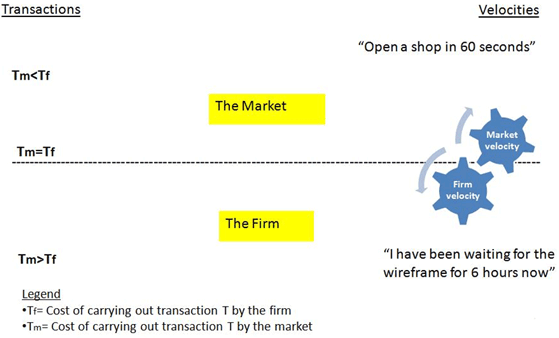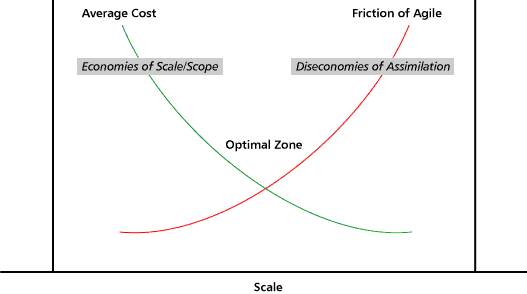Assertion 196
The rules of the game for attainment of commercial success by established firms are changing faster than anyone can say "change." Technological excellence, of course, still counts. However, it primarily counts as an element of nested business designs. In such designs, the ability of the company itself to be affected through learning and changing is as important as its aspirations to affect customers, markets, and value chains.
Syllabus
The immediate benefits that progress in one technology or another are very real to all of us. We quickly download bigger and bigger files; we immediately reach folks located thousands of miles away when we ourselves are on the road running to catch a plane; we find a recommended restaurant in an area we are unfamiliar with by shaking our iPhone. The list of such benefits goes on and on.
Firms that enable us to do such things, and myriad others, create unquestionable value. There is something seductive about being able to carry out a meaningful task an order of magnitude better/faster/easier than we were able to do so in the past.
While an established firm can certainly continue to base its competitive strategy on product excellence in one technology or another, this kind of success is becoming more and more precarious. The cloud, in combination with mobile and social technologies, has leveled the playing field in a way that enables millions, if not billions, of participants to "play" in as effective a manner as an established company. This leveling effect profoundly changes the way in which:
-
Markets form
-
Value is realized
-
Organizations respond
The compound effect of these three dimensions of change obsoletes many of the classic business designs as they fail to cope with the fact that change itself is changing. To attain sustainable success, a firm must develop and implement business designs whose fundamental premise is that change is not only constant, but also bidirectional: the firm must be able and willing to change as much as its own aspirations to change the market, and possibly more.
Contents
- Opinion by Israel Gat
- Concurrence by Tim Lister
- Concurrence by Lynne Ellyn
- Partial Concurrence by Robert D. Scott
- Partial Concurrence by Lou Mazzucchelli
- Partial Concurrence by Ken Orr
- Concurrence by Vince Kellen
OPINION BY ISRAEL GAT
From Photo Processing to Everyone as a Merchant
Let's start with a look at the photo-processing business as an illustration of both the nature of change and the speed of change. On the face of it, photo processing is a fairly mundane business. Having taken a few photos, the photographer would like to produce copies to share with others. Traditionally, the image was latent on the photographic film. One had to physically take the film to an outlet that would expose the latent images and turn them into visible images. A second trip to the outlet would be required to pick up the photos (and the film).
As of the mid-1990s, digital imaging "freed" the image from the "chains" of the photographic film. One could -- and millions first thence billions -- upload, organize, distribute and share photos. A quick look at the "photo sharing" entry in Wikipedia1 reveals 27 online photo-sharing websites. Moreover, the very same entry discusses eight distinct revenue models. These models reflect the progressions from the straightforward "money for your pictures" paradigm to more elaborate business designs, such as offering free photo-sharing services based on value recapture through advertising.
While one tends to associate photos with memories, the fact of the matter is that a photo can be used in various ways. For example, Pinterest has recently demonstrated how interesting the posting of pictures on a pinboard can be. By "pinboarding" an image, the picture becomes a part of a broader ensemble. The context within which users view that photo becomes inseparable from the photo itself. Clearly, a photo is no longer only "worth a thousand words" -- it might very well be worth many thousands of words in the context(s) in which viewers see it.
Moreover, one can very easily tag a picture to indicate a price for the object depicted in the picture. In fact, websites such as Wisemarkit and Fancy do just that, enabling the creation of stores (and, of course, the buying of items in these stores2 ) in mere seconds. The creation and display of "inventory" becomes a simple photo-upload-tag sequence. If the person tagging the photo would like to have richer functionality than that provided by Wisemarkit or Fancy, easy-to-use integrated platforms for listing, advertising, payment, and inventory management such as Etsy are also readily available.
What is remarkable about this progression in photography is that the semantics of "processing" a photo have changed big time.3 First, it was about producing a hard copy; next, it was about electronic sharing; today, we have selling through tagged photos. Not bad at all if you are among those driving the change; catastrophic if you lag behind (as the painful history of Kodak demonstrates).
Formation of Markets
Photos can be aggregated across multiple photographers. Such aggregation can be used to show what is really going on at any point in time in just about every place in our solar system. For example, Figure 1 shows what is going on midday in New York. Figure 2 illustrates what is going on in Paris at this time. In Figure 3, we return to New York to see what is going on there at night. The photo streams depict the ebb and flow of activities in just about any place of interest to a marketer.

Figure 1 -- New York at midday.

Figure 2 -- Paris at midday.

Figure 3 -- New York at night.
More than a decade ago, The Cluetrain Manifesto 4 characterized markets as conversations between the buyer and the seller. While this premise is certainly true, or at least desired, the fact of the matter is that markets are now formed through actions. An individual becomes a merchant "in 60 seconds" by tagging the photos he or she shares. A market (potentially) forms through the aggregation of photo streams, whether tagged for selling or just as data points that reveal what's hot at any point in time. But what about value?
Value Realization
The value of a car that leaves the production line is fairly predictable. Within a month or two, the car will be sold by a dealer to a customer at some markup price above the cost determined by the manufacturer. The markup might be small or large, but the value can be safely determined once the car has been produced.5 It might take another month or two for the car's value to be realized, but its value had essentially been created at the completion of the car's production.
Contrast this predictability with value realization through photo sharing along the lines described above. It is quite speculative to assume that value has been created once the photo of an item has been posted together with a tag indicating its price. Value might only be realized at an unpredictable point in time in the future. Moreover, the value is likely to be realized through a value web of similar merchants.
From Value Chains to Value Webs
Value chains used to be linear and static. In our photo-sharing example, the value chain is neither static nor linear. One cannot know, let alone predict, which merchants will be connected to the person who photo-shared an item to be sold at some future time. Nor can one know in advance what other offerings, in conjunction with the item photo-shared for selling, will lead to the realization of value.
Consider the very simple example of selling a photo (as distinct from selling the item displayed in the photo). A merchant offers to sell a photo of an incredible goal from the World Cup. The photo itself could, of course, be sold standalone based on its own merits. Or, the photo might only be sold in conjunction with 49 other photos from the World Cup. Alternately, it might only be sold as part of an exquisitely styled photo album based on a designer's template.
Neither the folks who added value6 to the original photo, nor the ways in which they actually added value to it, could be foreseen and foretold, let alone fore-planned, by the merchant who posted the original photo. To realize value in this manner, the merchant must be part of a value web. Ditto for whichever firm provided the photo-sharing platform.
If you accept the premise of value webs as both dynamic and nonlinear, the inevitable conclusion is that the nature of the firm -- and the way it interacts with the market -- changes profoundly. "Social emerging as [the] starting distribution point for content"7 becomes "Social emerging as [the] starting distribution point for e-commerce" in the context discussed above. It is to this profound change in the nature of the firm that we turn next.
Responding to Change
The classic economic model of the relationship between the firm and the market8 focuses on the cost of carrying out transactions. A firm tries to bring inhouse transactions it can perform in a more economical manner than the market. Conversely, the firm has no interest in bringing inhouse transactions that the market can execute in a more efficient way. The boundary between the firm and the market forms at the point in which the cost of carrying out a transaction inhouse is identical to the cost that this transaction could be carried out in the market. Figure 4 is a conceptual illustration of how relative costs establish this boundary.

Figure 4 -- Boundary between the firm and the market.
Consider an internal process such as the software process in the context of emerging firms like Wisemarkit or Fancy. As Figure 4 shows, a developer in a product team might be gated for six hours waiting for a wireframe to be completed by a designer. While the developer performs other useful tasks (such as thinking) during this waiting period, a certain deliverable has been delayed for six hours, and quite possibly longer due to subsequent downstream delays. Ask yourself, "Could a development/delivery delay of six hours be consistent with serving markets in which a competitor might be able to open a shop loaded with a new line of goods in 60 seconds?"9
The answer to this specific question is, of course, "It depends." The firm might or might not be serving the kind of markets in which "in 60 seconds" is a critical competitive aspect. For example, the product a company produces might be subject to a long regulatory process that the firm can't optimize.
Going beyond this very specific question regarding the time to opening a shop, the more general question is about the velocity of internal processes vis-à-vis market-related processes. If the velocity of internal processes is much lower than that of related processes in the market, then the firm might need to revisit an internal process such as the software process. In terms of a notation similar to that used for costs in Figure 4, assume Vf denotes the velocity with which the firm carries out the software process. Likewise, Vm denotes the velocity with which the market carries out some related process. A condition characterized by Vf<Vm is a very good reason to reassess whether a software process is suitable for pursuing the firm's business objective(s).
Think about the boundary between the firm and the market in terms of relative velocities. If the firm can't directly align the velocity of its internal processes with those of related processes in the market, it can mitigate the disparity through an intermediary that carries out certain tasks faster. There are three primary kinds of intermediaries in use in the software industry these days:
-
Boutique agile outsourcers that specialize in a specific domain. For example, Tech Propulsion Labs carries out mobile development faster than traditional waterfall shops.
-
Crowdsourcing companies that pull together talent irrespective of geography. For example, a firm can improve its effective velocity by offloading certain (or all) testing tasks to a crowdsourcing company such as uTest.
-
The "startup within a large firm." The firm shields off -- either physically or virtually -- a "tiger team" empowered to operate like a startup instead of adhering to the various rules and regulations of the large firm. Indeed, a couple of large clients of mine reverted in 2012 to this mode of operation.
Strictly speaking, a "startup within a large firm" is not a different legal entity; the purpose of forming it is similar to that of employing boutique outsourcers and crowdsourcing companies. Each allow a firm to carry out some tasks faster than using its standard processes. The formation of boutique agile outsourcers and crowdsourcing companies are an extension to the traditional boundary of the firm, whereas a startup within a large firm does not affect this boundary.
Whether the firm seeks the good services of a boutique outsourcer, contracts with a crowdsourcing company, or initiates its own startup, sooner or later it faces the challenge of scaling the success it derived through these means. We will use the startup within a large firm as an example why this kind of scaling is a wicked change management problem.
The Nested Business Plan: Connecting Macro with Micro
It is definitely possible, and often desirable, to initiate a startup within a large firm by emulating the way a typical startup operates. Assuming the startup eventually becomes successful by using appropriate metrics such as validated learning,10 the riddle the firm needs to solve is how to scale success. It is a difficult riddle as it exposes the inherent inconsistency in the phrase "startup within a large firm." A large firm usually has well-established channels and processes to enable scaling big time. It is, however, the very nature of these scaling mechanisms that hinder success in the first place; such scaling mechanisms operate at a glacial speed that can't satisfy the needs of the market. The firm might still have initial success using its vanilla scaling processes, but it is not likely to be able to sustain the pace the market demands unless it revises its scaling vehicles. Figure 5 demonstrates this inherent conflict: economies of scale (and possible scope) are offset by diseconomies of assimilation and change.

Figure 5 -- Diseconomies of assimilation and change.
A necessary -- though, of course, not sufficient -- condition for a startup within a large firm to succeed is to develop a nested business design (see sidebar). At the startup level, the business design is not much different from that used in ordinary business plans: fundamental assumptions, customer selection, scope, differentiation, value recapture, go-to-market mechanism, and so on. At a higher level, a key element of the nested business design is the way in which the large firm itself will change in order to scale the success of the "startup." Without such a layer addressing how change in the "mother ship" will happen, scaling is not likely to be sustainable due to the inherent diseconomies.
Prerequisites to Nested Business Plans
There are two major difficulties in devising the layer in the business plan that addresses change in the established firm:
-
Effect of change in complex 11 environments. More often than not, we do not know in advance what the change might lead to. We only learn what the change led to post factum. It is quite possible a change will be for the worse.
-
Having an effective method to wisely carry out change in a complex environment.
Satisfactorily coping with change in a complex environment requires a new breed of leaders. Venture capitalist Mary Meeker's language from a recent technology conference is so very appropriate for characterizing this breed: "aggressive (and informed) 'on my watch' executives in 'traditional' companies."12
Having an effective method to systemically initiate changes in a complex environment requires more than courage, fortitude, and "on my watch" attitude. It takes a systemic set of practices to implement changes that lead somewhere (e.g., turn learnings into earnings) as distinct from making changes "for the heck of it." These days we are beginning to see emergent practices for systemically managing change in complex systems. For example, the Minimum Viable Change (MVC) approach, recently proposed by Jeff Anderson,13 is a promising first step in this new direction of change management. It will no doubt be continually refined as it gets practiced in various Cutter engagements and elsewhere.
The Established Company Conundrum
A client of mine had invested an emperor's ransom trying to get into mobile. The client ultimately gave up on this venture, assessing that it was too late to successfully compete in the mobile market. Another one of my clients is currently fighting its way into the cloud. The client's own assessment of success to date is "miserable." If your company is facing similar challenges, it only has three options:
-
Acquire a foothold in the desired market through one (or at least a small number) of "proven" acquisitions. Note that you will inevitably need to make some changes in your company in order to successfully assimilate the acquisition(s) and scale them.
-
Invest the money slated for entering the desired markets by placing small bets on a diversified portfolio of promising startups in the desired market space. To attain the benefits of a diversified portfolio, you must change the way you govern in a manner that will accept "just" a couple of great successes in a portfolio of a few dozen companies. Once you have a couple of such successes on your hands, you could do one of two things: (1) scale up these successes in the manner discussed for M&As; or (2) evolve the commercial success without integrating the successful company in your own firm.
-
Initiate a "startup within a large firm" along the lines discussed earlier.
Whichever path you choose, you will inevitably need to change the way you do things. This is as important as the way you want to change your target market. While this Opinion restricts itself to discussing the third course of action -- startup within a large firm -- it is applicable to any of the three. Unless you are satisfied with your firm merely being a portfolio manager, your business design must include a layer about how your firm will change to scale success. By so doing, you will create your own nested business design.
Concluding Thoughts
It does not really matter whether you are a CEO, CIO, CTO, CMO, or CFO -- when change is constant, change management becomes the very heart of your job definition. Like it or hate it, the way you manage change might be more important than the way you keep up with, assimilate, and apply the latest and greatest developments in your core discipline.
Before you start managing change along the lines recommended here, you must be clear on how much you, personally and professionally, are willing to change. You are not likely to find this very elusive aspect of change written anywhere in your formal job description. However, your success or failure, critically depends on your own ability to change.
NOTES
1See Photo sharing (Wikipedia).
2Indeed, Facebook is experimenting these days with a "Want" button. See: Darwell, Brittany. "Facebook Wants Open Graph Language to 'Feel Natural,' Represent Actual Behavior." Inside Facebook, 22 October 2012 (www.insidefacebook.com/2012/10/22/facebook-wants-open-graph-language-to-feel-natural-represent-actual- behavior).
3Needless to say, these semantics could, and probably would, be changed further through 3D printing. Exciting as the topic might be, it is beyond the scope of this Council Opinion.
4Levine, Rick, Christopher Locke, Doc Searls, and David Weinberger. The Cluetrain Manifesto, Basic Books, 2000.
5As the 2007-2009 Great Recession painfully demonstrated, it might not be that straightforward to realize the value of a car in a time of great financial upheaval. This topic, however, is fodder for another day.
6This new breed of folks is often called "prosumers."
7Attributed to Chill founder Brian Norgard. In Meeker, Mary. "Internet Trends." Presented at D10 Conference, Rancho Palos Verdes, California, USA, 30 May 2012.
8Coase, R.H. The Firm, the Market and the Law. University of Chicago Press, 1990.
9An even more dramatic case of disparity in velocities is as follows: can such a six-hour delay be consistent with a world in which a last-minute purchasing decision at a checkout counter must be influenced in no more than three seconds?
10See the Lean Startup Methodology (http://theleanstartup.com/principles).
11"Complex" is being used here as defined by the Cynefin framework developed by Welsh scholar Dave Snowden, who illustrated the five domains of complex, complicated, chaotic, simple, and disorder "to illustrate the evolutionary nature of complex systems, including their inherent uncertainty" (Wikipedia). As a general rule of a thumb, software development can often be complex. In fact, a recent study of over 300 people involved in agile software development categorized 38% of typical activities in software development as complex. See: Perline, Joseph. "On Understanding Software Agility: A Social Complexity Point of View." Emergence: Complexity & Organization: An International Transdisciplinary Journal of Complex Social Systems, Vol. 13, Nos. 1-2, 2011.
12Meeker. See 7.
13Anderson, Jeff. "Lean Change Part 2 -- The Lean Change Stack." Lean Transformation, 26 August 2012 (http://agileconsulting.blogspot.com/2012/08/lean-change-part-2-lean-change-stack.html).
CONCURRENCE BY TIM LISTER
Blowing Out Those Ivy-Covered Walls
My assertion: When even revered, highly endowed universities face massive change, Israel is right: all institutions face their own massive changes.
As I write this, it is the last day I can submit my response to this Opinion without facing the editor's wrath of delivering a late essay. This time I'm glad I waited until the last minute before writing because something that I was watching from afar just zoomed into up-close focus for me this morning. I live in New York City, and one of the perks for NYC's denizens is home delivery of the New York Times before 7 am. Today's Times has an article about the astonishing developments of MOOCs, or massive open online courses.14
While my left brain read the article, my right brain pattern-matched it with Israel's opinion. Today's universities are facing a massive change, probably down to the core of their business models. This change is coming on strong and fast and will impact every university from the most elite to the local community college.
Consider some fun facts:
-
William of Durham endowed the first college within Oxford University in 1249.
-
Stanford University graduated 1,670 in the Class of 2011.
-
Harvard University has an endowment of US $31,728,080,000 as of 2011.
-
Princeton University estimates the cost of attendance in the 2012-2013 academic year, including tuition, room and board, at $54,780.
Universities have not fundamentally changed their value delivery --ever; it consists of a professor in a room with several to many students working through a topic in the arts, sciences, or engineering disciplines. Last year, Stanford University Professor Sebastian Thrun offered a free online artificial intelligence course and ended up with 160,000 students in his class from all over the world. If my arithmetic is right, Thrun taught more than 95 years' worth of Stanford students in one semester. He has now started his own online university.15 Take a look at the curriculum. Would you consider hiring a graduate? Look further at the names of all the universities that are participating in free online coursework.16 Would you consider hiring a graduate?
In assessing Israel's three options at the end of his opinion -- acquiring a foothold, placing small bets, and a startup inside the firm -- the first two aren't really options at all for universities. The startup option may well be a bit too late already, and the scaling looks like it will happen with multiuniversity alliances of some kind. Consider these questions:
-
What will happen to lower-tier universities?
-
Could this shift engulf education in the K-12 grade level?
-
Could it impact religious congregations?
-
What next? Your organization?
NOTES
14Lewin, Tamar. "College of Future Could Be Come One, Come All." The New York Times, 19 November 2012.
15See Udacity (www.udacity.com).
16See Coursera (www.coursera.org).
CONCURRENCE BY LYNNE ELLYN
Israel has articulately illuminated that business as we know it, isn't. In fact, the business of change -- and the change of business -- is accelerating at an ever-increasing rate. The ability for companies to harvest value and profits from this second-derivative function is obscured, chaotic, and unpredictable.
Yet even as I ponder this phenomenon, I am flattening this multidimensional challenge in a somewhat linear and familiar way of thinking about change. Yes, we are comfortable with the idea of constant change; we've all heard that change is the only constant. Further still, we are all familiar with the idea that the rate of change is increasing, sometimes decelerating profit trends as the tangibility of our profit plans dematerialize with cyber destructions behind every turn that no strategist could have envisioned. Poof -- our steady, increasing income stream vanishes against a paradigm cataclysm as technical tectonic forces collide, hurling customers at free alternatives or totally different lifestyles, making our "hot item" so yesterday. Hey folks: this doesn't look linear, predictable, or similar to any other time in the history of business.
So is this truly new? Is the new, new thing actually the destruction of business value by forces that scatter the value in ways that patents and copyrights can't protect or even fathom? I think the answer is clearly "yes" for products that lack materiality. Services based on sensory value (i.e., music, art, photographs, or design concepts such as business process or methods) are increasingly difficult to own or profit from. The Internet spreads concepts at the speed of electrons: ideas and products that are or could be digital escape the corporate petri dish and infect the world at blazing speed. The second- and third-order effects of these "escaped" ideas produce innovative and creative repurposing by dozens, or even thousands, of people or companies that build their own value without regard to the origin of the idea or design. Corporations are left gasping and wondering what happened?
Israel proposes some actions that you can take to make your company more capable of managing, and hopefully profiting, from all these creative and destructive forces. In the past, I would have applauded his logic, reason, and stepwise methods. Might be worth a try -- but today all I can truly say is good luck!
PARTIAL CONCURRENCE BY ROBERT D. SCOTT
I concur with Israel's fundamental (and obvious) assertion that organizations must develop new capabilities and capacities for change. Today's business, technical, social, economic, and political environments are all driving upheaval at an ever-increasing pace. No rest for the weary; the rate and impact of change is accelerating and will continue to do so. Israel goes on to assert that this change occurs along three dimensions:
-
How markets form
-
How value is realized
-
How organizations respond
Yes, I agree with these assertions as well. But the devil is in the details, and so are the keys for how organizations can and should respond. Let's look at each point in turn.
How Markets Form
The evolving nature of markets reflects the changing expectations/demands of each generation of customers that the market serves. For the first half of the 20th century, customers were largely "buyers"; the marketplace created and sold goods in accordance with customer demand. The basic rule of "supply and demand" dictated the market, and organizations that could balance the supply/demand equation were successful. In the latter half of the 20th century, customers became "consumers." Organizations could create demand through marketing techniques such as advertising, pricing strategies (gimmicks), coupons, and so forth. Through such tactics, companies could literally create new markets that had never existed, generate demand with customers, and encourage their consumption, thereby building even more demand. Organizational innovation and change capability expanded beyond product innovation to include consumer research, marketing, and selling.
The marketplace creation game took another major leap forward when technology and consumer sophistication moved into the "experience economy" of this century. Today's markets sell experiences, not products, and today's customers not only want to define a customized experience but they want the ability to be involved in the creation of that experience. As a result, marketplaces are now being created based on building "platforms" that enable customers to create their experiences. Building the organizational capability/capacity to create and support marketplaces that sell "on-demand" experiences (i.e., environments for participation in creating experiences that match the goals and preferences of individuals) is the new basis of competitive innovation.
How Value Is Realized
Israel correctly asserts that the classic value chain has morphed into a value web with value creation being distributed and nonlinear. Again, the details are what make this tricky. The old value chain focused on a linear flow of raw materials provided by suppliers through a transformation process that moved within the firm and then on to customers -- with some type of value added at each step. Today, this model has been replaced with a marketplace ecosystem that links the firm with suppliers, partners, contributors, channels, investors, and even competitors in a value creation web that creates (or destroys) value for customers. This value chain is nonlinear and increasingly self-organizing and open; interactions come and go dynamically, with value creation being situational based on market, players, customers types, and other interrelated factors. In this environment, organizations must be agile and adaptive with the openness to redefine relationships based on the current value definition, rather than getting locked into old, competitive paradigms.
How Organizations Respond
Finally, Israel puts forward three approaches for firms to be agile and adaptive:
-
Buy your way in; that is, leverage an acquisition strategy to gain a foothold in a new market.
-
Invest in startups, followed by a "weed or feed" strategy to leverage these investments (acquire/integrate or strategic partnerships).
-
Create an internal startup to experiment and learn.
While I agree that these are reasonable strategies for exploring new market possibilities, they are not the only strategies and they do not address the fundamental problem of evolving a culture of innovation within an organization. Without investing in the fundamentals of organization effectiveness (i.e., investing in systems, people, and process to design for agility), any short-term gains from Israel's approaches are not likely to be sustainable long term.
PARTIAL CONCURRENCE BY LOU MAZZUCCHELLI
Israel has crammed 10 pounds of ideas into a five-pound bag. This is not optimal for the ideas or the bag. Let's see what's in there:
-
There are generalizable rules for attaining commercial success.
-
These rules are not static.
-
The rate of change for these rules is increasing.
-
Nested business models can help deal with change.
Point 1 has been the topic of most of the business literature written since people began writing about business. Over more than a few centuries, we have derived two rules for commercial success that are invariant:
A. Make a product/service that people want to buy.
B. Sell the product/service at a profit.
The rest is detail. Some of that detail relates to changes in market demand. Some relates to servicing demand. To the extent we employ technology as a component of a product or service, or employ technology to service demand, a business experiences change at a rate that is moderated by the rate of technology change.
Watching the development of social media "businesses," I note that many have substituted the invariant B with a modified axiom B':
B'. Sell the business at a profit.
The proponents of B' are either unable or unwilling to sell their product or service at a profit but have found that a market exists for their unproven or malformed businesses. This is certainly a change in the rules for commercial success, but not necessarily one that contributes to the advancement of the state of the art.
The assertion also implies that invariant A has morphed, in some cases, into an A':
A'. Make a product/service that people might want to use but not pay for.
Obviously in this case, rule B cannot apply, so one path to success is to apply rule B'. Another is to create a derivative of the product or service, and then attempt to sell that at a profit. This is the business model for Google, Facebook, and others of their ilk. Thus, rule B'':
B". Sell the data about the use of a product/service at a profit.
Not that this idea is new. Survey, measurement, and advertising businesses have been around for a while (e.g., Gallup, Arbitron, Nielsen), but the emergence of social networking has produced a flurry of new business activity focused on that opportunity. Looming issues around those businesses have to do with robustness, value, and durability. We are drowning in data, and the appropriate solution in many cases is to turn off the flow. This realization will come and form another source of change for some managers.
The idea of nested business models is proposed as a way to deal with technology change. This is independent of the rate of change. The essential benefit of a nested business model is the same as intermediate objectives in military thinking: a clear objective, free of the distractions or other goals for the entire business, that can focus strategy and tactics to achieve that objective. In the case of an existing business, the nested business model can serve as a scouting mission to explore a new market development, or a feint to challenge potential competition. Both serve as tactics in support of a (hopefully) larger strategy.
As our world is not static, one cannot be in anything but agreement with Israel about the need to recognize and respond to change. However, we might disagree about what constitutes systemic change, and what is a technology-driven spasm at the margins of strategic intent. Those who mistake the latter for the former are likely to squander resources and opportunity.
PARTIAL CONCURRENCE BY KEN ORR
I am both encouraged and skeptical about Israel's opinion. It is certainly true that the world is moving rapidly from the world of designing, making, moving, and selling lumps of atoms to doing all the same things with bits. Surely everything that has to do with bits happens quicker, moves faster, and disintermediates at a greater pace than ever before. But even the people who run social media business (or photo aggregators) live somewhere, bank somewhere, and have (we hope) real customers.
While we live increasingly in a world that seems to operate at lightspeed, that same world depends upon things that are quite real: an infrastructure, for example, that is vast and expensive, consuming huge amounts of electricity and requiring equally huge investments in infrastructure. As my colleague Lou keeps bringing to our attention, someone has to pay for all the bandwidth we consume.
So it seems to me that Israel is both right and wrong. He is certainly right about the need for organizations that want to prosper in the Internet world to understand change at the most fundamental level, but -- and this is a big but -- another part of their psyche must be comfortable with planning in the long term. Look at the really big players in this new age -- Google, Apple, Amazon, Salesforce.com. These organizations saw the potential of the Internet, wireless, and smart devices, and so forth, but also set about to plan for them. So while it is true that the Facebooks and Pinterests and the like have been able to quickly leverage the hyper-mutic, they have also been able to switch from focusing on today to focusing on the long range.
Over the last few decades, we have seen various writers try to capture the essence of the organization of the future -- Porter, Peters, Moore, Christensen, Anderson -- and they have all captured a part of the puzzle, but there is no singular vision that can predict with any certainty. Certainly, agility is an import asset, but what happens after we have created an agile success -- we have to maintain it! Indeed, every day I find myself thinking, "What will the post-agile, post-social media world look like, 20 or 30 years from now, and how will we support it?"
CONCURRENCE BY VINCE KELLEN
"If you want soup, you have to stir the pot!"
So claimed my Polish grandfather, referring to not only the fish soup in question, but to life in general.
There is much in Israel's opinion to merit concurrence. Having happily and only very partially collaborated with him as he developed his thoughts, I concur. These days, businesses must change their business models fast, and many are ill-equipped to conduct the change, individually, or as teams. Nested models, not quite in favor at the moment, should be looked at again.
Israel rightfully outlines M&As and partial investments in a portfolio of startups as a means for firms to address the dynamism in competitive environments. One aspect of an industry, its reliance on IT, may matter. As industries become IT-intensive, meaning they rely on and invest in information technology more so than other industries, these industries generate two seemingly contradictory results. First, the barriers to entry lower, allowing more startups to flourish, at least for a while. Second, the industry becomes dominated by fewer and fewer large competitors until just a handful or less fight epic battles over most of the market share.
Sound familiar? Right now, we are witnessing what some in the IT industry have called a "knife fight to the death in a phone booth" -- being played out in full Godfather-like operatic form. Apple, Google, and Microsoft are in an epic battle over the mobile-tablet operating system and hardware space. Dell, HP, IBM, Cisco, VMware, EMC, Juniper, and a few others are duking out in the converged infrastructure space. In these environments, cooperation and competition are equally fierce. Meanwhile, all these companies are regularly acquiring, and even fighting over, critical startups. This market dynamic creates, in my opinion, a near-steady-state equilibrium between large and small forces. An endless crop of beautiful startups bloom for the biggies to pluck from their VC garden while these behemoths bludgeon each other to bloody pulps in the battle to gain dominion over all. Fun stuff.
Three years ago I spent 10 minutes in a CIO-startup speed date arranged by a company that coordinates IT conferences. The firm introduced to me on the "date" was manufacturing wireless access points designed to work with a cool wireless infrastructure management layer in the cloud. I thought the business case was interesting. Cheap WiFi access points. Nifty analytics in the cloud. Sold to CIOs tired of predicting WiFi mania at prices lower than the competition. I told him that his firm would be an acquisition target for Cisco, since it would threaten them. I had forgotten about this firm until recently. Just this month, I learned that Cisco acquired this firm, Meraki, for a mere $1.2 billion. I was directionally correct, but my amplitude was way off. I had no idea the deal would be valued so high. Such is the power of a pitched battle between large competitors and the availability of just barely enough good startups to buy.
Perhaps this M&A strategy proves so popular because firms find it easier to buy a new culture than to change one. Another savvy entrepreneur and executive put it more bluntly. The DNA of a company is like cement. It gets set early and solidifies fairly quickly. Israel correctly points out the need for a third alternative: nested business designs within the firm. Can firms successfully implement these designs? Israel hints at, but doesn't quite confront, the contradictions inherent in business strategy, which I think his opinion hovers over.
The need for scale and continuous improvement sows the seeds that become conundrums later. Once a business model sprouts quickly, the culture around it locks in. The more successful the growth, the more painful the future disembowelment. Like humans, firms seem to find it easier to let someone else slay them, then to actually remove their own core competency voluntarily. Worse still, some research suggests that one of the most sought-after benefits of successful growth, large piles of cash, may actually dumb the company down, luring it into M&A stupidity. Can you say HP? Planned demolition is far easier to do with old, empty baseball stadiums than with business models spewing profits. Can excessive cash hurt? Decrying the excess in higher education, people lament that Harvard's endowment is now at $32 billion, a point Tim highlighted. In the IT sector, Microsoft has cash and short-term investments of $62 billion. Which pile of cash creates the bigger blunder? Or will this amount of cushion let both organizations successfully implement nested business designs? Reading Harvard's woes in these times17 supports Israel's point: size isn't what it used to be.
A second common trap in business strategy is to assume deconstruction is inevitable due to the presence of what we now call "disruptive technology." Many pundits gleefully predict the entire collapse and demise of an industry on nothing more than faith-based strategy. The argument usually goes like this: "Yucky company. Yucky expensive product. Horrible waste. Disruptive technology! Democratization! End of yucky company! End of expensive product! My hero! Golden days ahead!" This is a familiar narrative going right back to the origins of literature. Unfortunately, predicting when nested designs, incremental or emergent designs, or any kind of business design will actually work is quite hard. It requires a combination of timing and deep insight into market dynamics and partially unknown customer needs. Business strategy, like software engineering, is the La Brea Tar Pits that ensnare the naively overoptimistic.
A third trap people fall into is to assume that business life at this edge of complexity, or even in chaos proper, favors certain kinds of companies or certain kinds of designs. In chaotic markets -- ones in which events are moving faster than humans can understand and new combinations of things emerge unforeseen -- action and inaction are indistinguishable. Both have equal chances of success. It is only when markets start to cool or take some stable form that advantage flows to the swift and agile. To do strategy right, one has to know the market is hot or warm.
Because of the IT media's incessant desire for underdog Superbowl story lines, I have come to the conclusion that the clearer the narrative, the less likely the projected outcome. While nature may abhor a vacuum, business abhors an ideology. Business designs need to be practical and allow for quick and iterative learning for both the firm and its customers. The heat has to be on, a loosely specified set of ingredients must be added, and an indeterminant amount and kind of stirring needs to take place by one or more cooks. Overspecification can be distasteful; a confident and inquisitive humility is in order.
Allez cuisine!
NOTES
17"Harvard's Sober Annual Financial Report." Harvard Magazine, 2 November 2012 (http://harvardmagazine.com/2012/11/harvard-reports-break-even-financial-2012).




